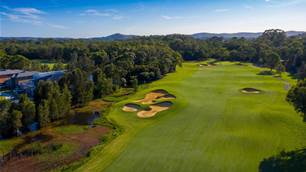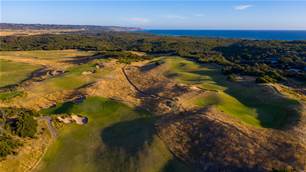In the late 1980s Palm Meadows was at the forefront of a new wave of resort courses being constructed in Australia.
Then, in August 2010, a closed sign was strung across the car park entrance.
Today, nearly 14 years on and still under the management that rescued the seemingly doomed layout, Palm Meadows is flourishing to be one of the Gold Coast’s most popular courses.
In issue No.4 of Golf Australia magazine, the late, great Tom Ramsey, who was then consulting editor, wrote about “an exciting new creation on the Gold Coast.”
He and photographer John Knight had visited the Palm Meadows layout in March 1987, as construction was nearing completion on the first Australian course to be created by the design team, Graham Marsh and Ross Watson. More than $30 million had been spent by the Japanese company, Daikyo Kanko Co., in creating the course and luxurious clubhouse.
Ramsey wrote: “More courses like Palm Meadows are sorely needed on the Gold Coast, which has lacked championship quality courses for too long.
“There are more courses planned, including the $500 million Sanctuary Cove with two courses and Peter Thomson’s Hope Island layout. They are exciting times … ,” he predicted.

He wasn’t far from the mark as Palm Meadows certainly set the benchmark at the front end of the Gold Coast resort course building boom in the late 1980s and early ‘90s.
It was hard not to be seduced by Palm Meadows’ class. I don’t know if it was the concierge who met you at the bag drop, or the luxury of taking a Japanese bath in the clubhouse whilst overlooking the course or even experiencing a consistently well-presented golf course. Maybe it was all that and a bit more.
Then, of course, Palm Meadows became a Tour-stop for the Australasian Tour for five years until 1992, with the Palm Meadows Cup attracting the biggest names in golf at the time including Greg Norman, Bernhard Langer, Nick Faldo, Curtis Strange and Ian Woosnam.
By the mid-90s Daikyo was looking to sell Palm Meadows and they found a willing buyer in Macau casino magnate Stanley Ho. Through an associated company, Hungtat Worldwide, Ho paid $50 million in 1996 for the course and some adjoining land for the 292-room Mercure Gold Coast Resort.

Palm Meadows remained among the best layouts on the Gold Coast for a few years after the sale. But as the end of the century approached, the course went into gradual decline. The Gold Coast’s sub-tropical climate took a toll on Palm Meadows’ presentation and, by the summer of 2000-01, it was often tainted by outbreaks of disease and weed infestation, which especially affected the quality of the putting surfaces. In the years to follow, Palm Meadows’ conditioning woes continued as irrigation, drainage, and the shrinking of the greens due to couch encroachment were not fully resolved.
With green fee players staying away in greater numbers and memberships dropping, Hungtat Worldwide saw an opportunity in 2007 to redevelop the property into a racecourse, which would see the Gold Coast Turf Club move to the site. The proposal was scuttled by the turf club and the course survived, but dark clouds still loomed large on the horizon.
Those dark clouds arrived in July 2010 when Hungtat Worldwide announced the course would close because it “was no longer financially sustainable.” On August 1, the entry gate was locked, seemingly, for good. I recall, just a few weeks later, walking around part of the course’s boundary and being saddened to see how far the layout had slipped from its lofty perch of the late ‘80s.
Four months after the closed sign went up, Palm Meadows reopened its doors after a local management company brokered a lease agreement for the course with Ho and Hungtat Worldwide.
GC Golf Management took over the course when it was undoubtedly at its lowest ebb and haven’t looked back.

In the days after the course was reopened in 2010 it was like a golfing ghost town and the new management team might have had some nervous thoughts about their venture. Today, Palm Meadows is thriving both in its presentation and popularity, with 200 to 300 golfers (depending on the time of year) playing the famed course daily.
From this writer’s perspective, the course looks better than it has at any time since the late 1990s, which was validated by its rise in the national rankings when it grabbed the No.59 spot, up three places, in Golf Australia magazine’s Top-100 Public Access Courses for 2023.
“Palm Meadows is in a much better place than it was a decade ago, for example, it has added some presentation polish to its bunkering and fairways making it really grow in my estimation,” ranking judge, Joe Thomas, said.
Fellow judge Ken Robinson added: “Palm Meadows is resort course 101. Big greens, big bunkers, big water hazards and wide playing corridors. But it is fun golf. Who doesn’t love skirting a drive along the edge of a lake to shorten up an approach into a massive two-tiered green surrounded by sand?”
Of note here, also, is the quality of the putting surfaces. Palm Meadows is one of only two courses remaining on the Gold Coast to have bentgrass greens, while every other course in the region, with the exception of nearby The Glades, has converted to a strain of Bermuda grass. During the cooler months on the Gold Coast, Palm Meadows arguably has the fastest and smoothest rolling greens in the Sunshine State.
I have always believed the front nine at Palm Meadows is where you can lay the solid groundwork to making a good score, while the inward half is a bit more challenging and a whole lot more fun.

The test of your skill builds through the mix of long par-3s and tight par-4s to a spectacular climax at the famous par-5 18th, which was once ranked among the top-500 holes in the world and closely resembles half a dozen holes to be found at tournament sites on the PGA Tour schedule.
The 17th and 18th, together, form a great finishing duo where tournaments have been won and lost and the layout can exact its revenge on the cocky golfer looking to beat his playing partners.
The 165-metre par-3 17th isn’t the best one-shotter at Palm Meadows, in fact it’s probably not in the top-two. But as a 17th hole it’s a beauty. With the clubhouse in sight and the chance of posting a good score, it would be easy to discount this hole as a pushover. But it is harder than that and any player who has found one of the two bunkers either side of the green will testify to that. Just hitting the green isn’t good enough here as the putting surface is full of slope and swale making even 10-footers a testing proposition.
And, of course, there is the 18th. A magnificent 523-metre par-5 which calls for courage, smarts and a pretty good golf swing to get away with par or better. The likes of Greg Norman, Nick Faldo, Rodger Davis and Co. liked to take the direct route on this hole – just right of the big bamboo patch that lies short of the fairway and beyond the lake. There is a ‘no guts, no glory’ tag which hangs on this hole for every would-be Norman who ventures to Palm Meadows. “Should I go for it?” you will probably ask yourself. Try it but make sure you can carry the ball at least 245 metres on this Tiger line.
If there is a lottery ticket hanging in the balance, you may want to follow the lead of two-time U.S Open Champion Curtis Strange, who always followed a set game plan and drove well left of the bamboo to avoid the water. Taking this safe option will make par that little bit easier to achieve and birdie a real chance. The final approach to the green is a memorable one. If you have followed Norman’s route, a 5- or 6-iron will be enough to reach the green beyond a canal that connects two lakes either side of the fairway. Taking Strange’s route, lay-up with a long- or mid-iron and pitch a wedge into the huge green.
FACT FILE
LOCATION: Palm Meadows Dve, Carrara, Queensland
CONTACT: (07) 5594 2450
WEBSITE: www.palmmeadows.com.au
 DESIGNERS: Graham Marsh and Ross Watson (1987).
DESIGNERS: Graham Marsh and Ross Watson (1987).
PLAYING SURFACES: Penncross bentgrass (greens); couch (fairways, tees and rough).
COURSE SUPERINTENDENT: Blaine Knox.
GREEN FEES: $89 (seven days). $49 (twilight after 2pm). All prices include cart hire.
PGA PROFESSIONALS: Sean and Mark Bath.
ACCOMMODATION: The neighbouring Mercure Gold Coast Resort is spread over 10 acres of lush tropical gardens, with all rooms opening onto either a balcony or patio with views of the resort’s gardens, pool or the golf course.
ACCOLADES: Ranked No.59 in Golf Australia magazine’s Top-100 Public Access Courses for 2023.
Related Articles

Top-100 Spotlight: Kooindah Waters Golf Club

Drinks With... Ricky Ponting













